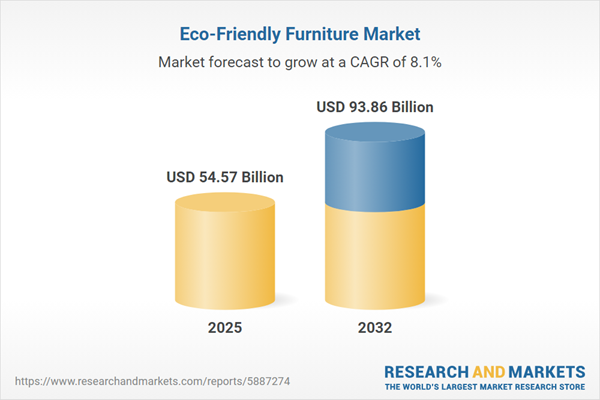Speak directly to the analyst to clarify any post sales queries you may have.
The eco-friendly furniture market is evolving procurement strategies for organizations by aligning sourcing, compliance, and sustainability goals. As businesses expand responsible supply chains, decision-makers are seeking solutions that integrate environmental priorities without compromising operational efficiency.
Market Snapshot: Eco-Friendly Furniture Market Growth Overview
In 2024, the eco-friendly furniture market is marked by substantial growth, underpinned by increasing corporate commitments to sustainable practices. The market’s valuation is expected to reach USD 50.44 billion, maintaining a healthy compound annual growth rate (CAGR) of 8.07%. Drivers include robust demand for responsibly sourced materials, heightened transparency across supply chains, and regulatory frameworks encouraging certified procurement. Companies are prioritizing traceability and compliance to ensure resilience and to satisfy evolving stakeholder expectations in dynamic regulatory environments.
Scope & Segmentation
- Product Types: Includes beds, cabinets, chairs, sofas, and tables, each supporting flexible design requirements for offices, hospitality spaces, residential developments, and mixed-use settings.
- Material Types: Utilizes bamboo, metal, rattan, and recycled wood, emphasizing support for circular economies and adherence to stringent environmental certifications.
- Sales Channels: Furniture stores, hypermarkets, specialty outlets, supermarkets, direct ecommerce, and third-party platforms—each streamlining procurement for organizational projects.
- End Users: Serves commercial buyers in office and hospitality sectors, along with residential consumers targeting sustainable solutions for both work and leisure environments.
- Distribution Channels: Offers direct sales, partnerships with authorized distributors, retail networks, and wholesalers to optimize procurement and deliver tailored solutions for varying project scales.
- Price Ranges: Economy, midrange, premium, and luxury segments enable procurement teams to address specific budgetary guidelines and investment strategies.
- Applications: Solutions span bedrooms, dining spaces, living areas, workspaces, outdoor areas, balconies, and gardens to meet the diverse needs of private and commercial projects.
- Styles: Features contemporary, modern, rustic, and traditional aesthetics, facilitating alignment between organizational branding and environmental messaging.
- Regions & Countries: Americas, Europe, Middle East & Africa, and Asia-Pacific, with a focus on key markets like the US, Canada, Brazil, UK, Germany, China, India, and Japan to navigate compliance and sourcing nuances.
- Technologies & Processes: Advances include modular construction, bio-based and reclaimed materials, digital customization platforms, and blockchain tools, all strengthening procurement validation and product quality.
Key Takeaways: Strategic Insights for Decision-Makers
- Integrating sustainability criteria into procurement directly boosts supply chain resilience and addresses regulatory and stakeholder imperatives.
- Adopting modular and adaptable furniture supports evolving workplace requirements and optimizes resource allocation.
- Digital procurement platforms, especially those utilizing blockchain, increase sourcing transparency and foster better supplier collaboration across decentralized networks.
- Regional strategies must be nuanced: European organizations emphasize compliance and supplier transparency, North American firms focus on mitigating sourcing risk, and Asia-Pacific businesses tailor processes for manufacturing agility.
- Prioritizing recognized ecolabels, comprehensive lifecycle management, and tamper-proof traceability builds organizational accountability and sustains long-term partnerships.
Tariff Impact: Navigating Policy Changes
Recent shifts in US tariff policies are prompting organizations to revisit sourcing and procurement strategies in the eco-friendly furniture market. Strategies such as supplier diversification, nearshoring, and developing domestic manufacturing capacity are increasingly important. Flexible sourcing approaches and modular production capabilities help minimize exposure to trade disruptions and enable business continuity throughout periods of regulatory adjustment.
Methodology & Data Sources
This assessment draws on secondary data, interviews with executives, and insights from supply chain leaders, furniture designers, and procurement specialists. The research incorporates industry statistics, regulatory reviews, and targeted workshops, ensuring the findings are actionable for senior decision-makers focused on B2B procurement.
Why This Report Matters: Actionable Insights for Leaders
- Enables organizations to benchmark procurement and supply chain strategies against global sustainability standards specific to the eco-friendly furniture industry.
- Provides actionable frameworks to anticipate regulatory shifts, respond to changing tariffs, and optimize distribution models while managing operational risks.
- Delivers a comprehensive view of segmentation and emerging technologies, supporting investment decisions and market expansion across both established and growth regions.
Conclusion
Prioritizing sustainability in procurement and compliance unlocks operational value while affirming organizational credibility. Insights from this market foster informed decisions that align business objectives with environmental responsibility.
Additional Product Information:
- Purchase of this report includes 1 year online access with quarterly updates.
- This report can be updated on request. Please contact our Customer Experience team using the Ask a Question widget on our website.
Table of Contents
3. Executive Summary
4. Market Overview
7. Cumulative Impact of Artificial Intelligence 2025
Companies Mentioned
The companies profiled in this Eco-Friendly Furniture market report include:- Ingka Holding B.V.
- Ashley Furniture Industries, LLC
- MillerKnoll, Inc.
- Steelcase Inc.
- Ethan Allen Interiors Inc.
- Haworth, Inc.
- Teknion Corporation
- Bassett Furniture Industries, Inc.
- Flexsteel Industries, Inc.
Table Information
| Report Attribute | Details |
|---|---|
| No. of Pages | 196 |
| Published | October 2025 |
| Forecast Period | 2025 - 2032 |
| Estimated Market Value ( USD | $ 54.57 Billion |
| Forecasted Market Value ( USD | $ 93.86 Billion |
| Compound Annual Growth Rate | 8.0% |
| Regions Covered | Global |
| No. of Companies Mentioned | 10 |









